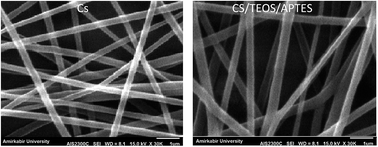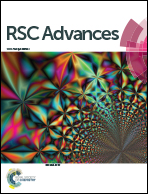Fabrication of chitosan/silica nanofibrous adsorbent functionalized with amine groups for the removal of Ni(ii), Cu(ii) and Pb(ii) from aqueous solutions: batch and column studies
Abstract
A chitosan/tetraethylorthosilicate/aminopropyl triethoxysilane (CS/TEOS/APTES) composite nanofibrous adsorbent was prepared via an electrospinning process. The performance of the prepared nanofibers was investigated for Ni(II), Cu(II) and Pb(II) ion sorption in single and ternary systems. The prepared nanofibers were characterized using FTIR, SEM and BET analysis. The effects of sorption parameters including pH, contact time, initial concentration and temperature were evaluated in a single system. The maximum sorption capacities for Ni(II), Cu(II) and Pb(II) ions onto the CS/TEOS/APTES nanofibrous adsorbent were found to be 696.2, 640.5 and 575.5 mg g−1 at an equilibrium time of 30 min and at 45 °C. The kinetic and equilibrium data were well described using pseudo-first-order kinetic and Langmuir isotherm models. The calculated thermodynamic parameters indicated a spontaneous and endothermic adsorption process. A Box–Behnken design was used to evaluate the effects of four parameters including pH and initial concentration of Ni(II), Cu(II) and Pb(II) ions on the sorption efficiency. The selectivity order of metal ions onto the CS/TEOS/APTES nanofibers was Ni(II) > Cu(II) > Pb(II) in a ternary system. In fixed bed column studies, the Ni(II), Cu(II) and Pb(II) sorption capacities were increased by increasing the flow rate up to 4 mL min−1. A Thomas model predicted well the adsorption capacity of metal ions in a fixed bed column. The removal efficiency of metal ions by the regenerated nanofibers did not significantly change in both batch and fixed-bed column studies.


 Please wait while we load your content...
Please wait while we load your content...